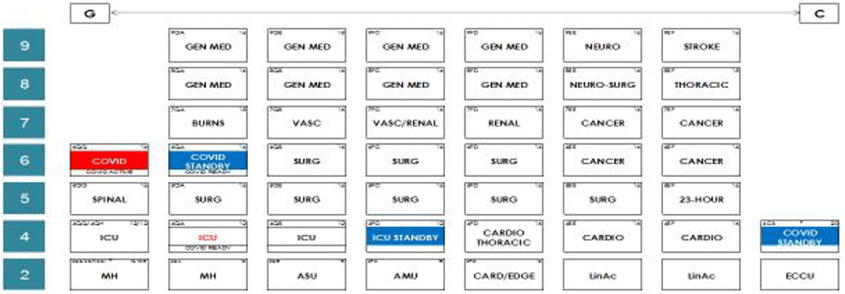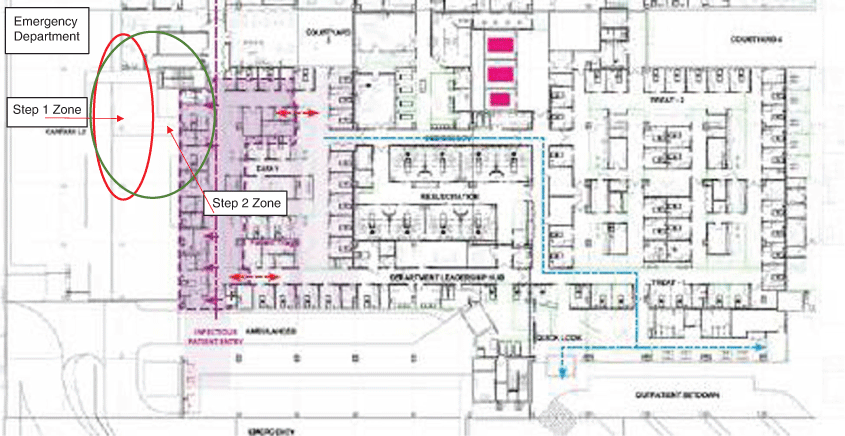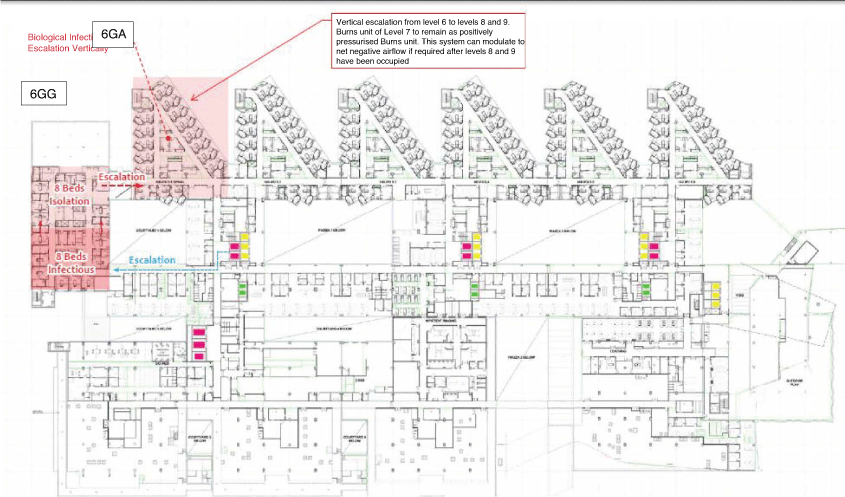Hospital design features that optimise pandemic response
Elke Kropf A and Kathryn Zeitz A B CA Central Adelaide Local Health Network, Port Road, Adelaide, SA, Australia. Email: elke.kropf@sa.gov.au
B Adelaide Nursing School, The University of Adelaide, Adelaide, SA, Australia.
C Corresponding author. Email: kathryn.zeitz@sa.gov.au
Australian Health Review 46(3) 264-268 https://doi.org/10.1071/AH21153
Submitted: 29 April 2021 Accepted: 29 September 2021 Published: 17 March 2022
Journal Compilation © AHHA 2022 Open Access CC BY
Abstract
The COVID-19 pandemic has changed forever how we plan, respond to, and deliver health care. The lived experience of hospital infrastructure design to support a pandemic is currently not well described in the literature. Much of what is known covers generic elements of hospital design and/or assumptions about in-built disaster design features. The Central Adelaide Local Health Network became a key stakeholder in South Australia’s response when the Royal Adelaide Hospital (RAH) became the designated receiving hospital for the state. Preparation for a pandemic commenced back in 2007 when a new build for the RAH was announced. Several disaster response infrastructure design features were incorporated into the RAH design specifications to provide a resilient facility that could respond to any type of disaster event while continuing to provide core clinical services. Key pandemic design elements included patient room design, pandemic air handling capability, and a 7-step scalability function. We describe these key elements based on real-time experience along with the key lessons learnt as the pandemic response evolved with the aim of guiding future hospital building design to not only support the more frequent time-limited disasters but, more specifically, a pandemic response. The RAH capitalised on its key design features to support its pandemic response and contributed to the overall success of South Australia’s pandemic response.
Introduction
The Royal Adelaide Hospital (RAH) admitted the first patient in South Australia (SA) with SARS-CoV-2, formally known as Coronavirus, on 1 February 2020; however, the journey to the RAH readiness for a pandemic response started many years before.
The RAH is the main acute tertiary and quaternary hospital in SA with approximately 800 beds. The Central Adelaide Local Health Network (CALHN) is the governing entity for the hospital. The RAH is a new build that was commissioned in September 2017. The building includes several features that support a pandemic response. This was well before the World Health Organization declared the COVID-19 pandemic in March 2020.
As a key element of SA’s successful management of the COVID-19 pandemic, this article describes the key features of the hospital infrastructure that have been enacted to support the RAH’s role as the primary receiving hospital for the state.
Background
In 2007 it was announced a new RAH was to be built in Adelaide, SA. Disaster readiness was a key consideration when the process commenced. The intent was to provide a resilient facility that could respond to any type of disaster event while continuing to provide core clinical services. This decision was influenced not only by the need to manage internal infrastructure failures, but also due to awareness of previous issues and events that had occurred nationally and internationally. As a result, several disaster response infrastructure design features were incorporated including:
-
Pandemics. The previous SARS and H1N1 outbreaks pointed to the need for containment and segregation. The opportunity to increase Class N rooms (negative pressure) and introduce Class Q rooms (full quarantine) was important, as well as how to manage escalating volumes of presentations. Another recommendation was the co-location of infectious diseases capability with an ability to flow into adjacent space.
-
Natural disaster. Because Adelaide lay on a fault line and this affected the site, earthquake integrity was also a consideration. While the National Construction Code1 and Australian Health Facility Guidelines2 focused on structural integrity, the goal was to also ensure functionality of core clinical services post an event.
-
Seismic performance. The design ensures resistance to the stringent earthquake conditions with a large building footprint, subdivided with separate smaller adjoining segments called sectors. These 18 sectors behave and move uniquely during an earthquake, both laterally and longitudinally with physical gaps between sectors.
-
Single points of failure. Resilience and flexibility in design ensures the facility can adapt to various challenges, from both a public health and disaster perspective, to maintain continuity of service.
-
Island mode. Another component arising from the National Construction Code1 and the Engineering Guidelines for Healthcare Facilities3 was ‘island mode’. The goal was to ensure the hospital can be fully functional for at least 48 h without any external support for utilities. Physical connection to external infrastructure or services such as communications was minimised and on-site storage for water and bulk gas tanks was optimised. The only exception to this is diesel, with monitoring of fuel consumption to allow adequate time for delivering to the facility.
-
Inbuilt dual supply and redundancy. Design features ensure electricity and water are fed from two separate supply feeds and engineering systems providing redundancy in the form of additional equipment were installed, allowing maintenance and potential equipment failure to occur while retaining full essential services operation. Key engineering systems were installed in two different locations across the facility to minimise any single points of failure, including chilled water, medical air, heating water system and information communications and technology.
In addition to the disaster response considerations described above, there are several design features that support pandemic capability. These came to the fore in March 2020, with SA declaring a public health emergency in response to the COVID-19 pandemic. By the end of 2020 CALHN had managed 100 patients at home who were COVID-19 positive through our Hospital in the Home service, the RAH had admitted 99 inpatients, with 18 being treated in intensive care and ultimately four deaths.
Pandemic design features
Although the RAH was designed for disaster capability, there are several features that support pandemics. These include patient room design, pandemic air handling capability, and a seven-zone scalable inpatient ward configuration. These features of the RAH have been capitalised on to support SA’s current pandemic response.
Patient room design
The first element supporting a pandemic response is 100% single rooms. The premise was to provide flexibility, secure patient privacy, more family/carer inclusivity, and reduce the number of movements a patient experienced as more treatments could be undertaken in their clinical space. This in turn reduced the number of additional generic spaces required for treatment/procedure rooms that are traditionally underutilised.
To enhance infection prevention management, built-in personal protective equipment (PPE) stations were included on the external corridor for each room, enabling donning of PPE before entering any single room. Each room has a standardised layout to aid infection prevention; for example, the hand basin is always located in the same position in relation to the door.
In addition, there is also a higher proportion (35 in total) of Class N rooms and three Class Q rooms. These are spread across the emergency department (ED), inpatient areas, the intensive care unit (ICU) and recovery bays.
The ICU was designed with 60 beds in pods of 12 and comprises five Class N rooms (with antechambers for applying PPE) and one Class Q room. A dedicated ‘pandemic ventilation mode’ prevents recirculation of potentially contaminated air throughout the ICU.
Pandemic mode
As the facility was being designed, a ‘pandemic mode’ was developed that evolved to include seven zones:
-
An initial zone and expanded zone in the ED.
-
An initial zone and expanded zone in Infectious Diseases.
-
Inpatient units (IPUs) on Levels 6, 8, and 9.
When set to pandemic mode, the heating, ventilation and air conditioning (HVAC) changes occur as follows:
-
Air handling units (AHUs) providing air to the zone go into 100% full fresh air mode/single pass mode to ensure fresh air is provided to the zone and all return air is exhausted out. No air is recycled.
-
Air supply into the zone is reduced to minimum levels while still meeting the Engineering Guidelines for Healthcare Facilities.3
-
Return air systems speed is increased to extract more air out of the space creating a net negative airflow in the space.
Pandemic mode also activates security card readers at the perimeter of each zone restricting access to authorised personnel only.
100% outside air in IPUs
In the early stages of the COVID-19 pandemic planning, consideration was given to what would occur should the positive COVID-19 curve increase dramatically, and the seven pandemic zones reach capacity.
An analysis was undertaken to determine whether the AHU supplying air to the IPUs could be put into 100% full fresh air mode/single pass mode and that any changes would have no effect on the HVAC fire mode capabilities.
The AHUs service IPUs vertically as opposed to horizontally across floors. A trial was commenced and the IPUs in the pandemic-enabled stack (see Fig. 1 for pandemic stacking concept) were put into 100% outside air mode to all levels, excluding those already in pandemic mode, the Burns Unit, and the ICU (serviced by different AHUs). This trial proved the facility could increase its capacity to accommodate patients in an environment where 100% outside air is both supplied and removed from the IPUs.
Though useful, limitations do exist around the use of 100% outside air in the IPUs in relation to the system’s ability to provide stable temperature and humidity levels. It was determined that the mode could be used if the outside air temperature was between 13 and 29 degrees and at humidity levels under 65%. If any of these parameters are exceeded, the system would default back to normal operation to ensure a comfortable environment.
7-Step pandemic scalability
The RAH was designed around clinical service and functional relationship stacking (Fig. 1). This in turn supported a 7-step scalability plan that was developed to respond to a pandemic. The pandemic mode steps broadly are:
-
Step 1: the ED isolates eight cubicles with a dedicated direct entrance.
-
Step 2: the eight cubicles can then be expanded to an isolated section of the ED inclusive of 26 cubicles and retaining the same dedicated entrance. The whole area is supported by greater negative pressure (Fig. 2).
-
Step 3: IPU Wing 6GG has direct access from the ED to the pandemic-enabled wing, usually the infectious diseases wing, for an initial six beds that includes five Class N rooms and one Class Q room.
-
Step 4: IPU Wing 6GG area can then scale up to 16 beds encompassing the entire wing.
-
Step 5: from the 6GG Wing, there can be further scaling up to a further 16 beds into Wing 6GA (Fig. 3).
-
Steps 6 & 7: involves using IPU above on Level 8, and then Level 9 with dedicated travel corridors.
This model also supports staff and patient cohorts moving seamlessly between spaces. Public and staff/patient travel paths are separated between clinical services.
COVID-19 testing clinic
Finally, the RAH established a COVID-19 testing clinic for the general public on site. This was established in clinical space with an external and separate entrance that was repurposed to provide a testing clinic. This meant people requiring testing did not have to traverse the main public access points within the RAH. Over time, additional temporary infrastructure was put in place to support the testing clinic, including temporary shelters to protect people from the weather and toilet facilities.
Lessons learned
Several physical and operational elements enabled CALHN to be a significant contributor to the success of SA’s response to the COVID-19 pandemic. There is no doubt we learnt a lot in real time, as the response evolved.
An early decision in our response was to optimise our physical footprint. This meant that while the RAH would become the state’s dedicated receiving hospital, our other tertiary site, The Queen Elizabeth Hospital (TQEH), would be our ‘clean site’. TQEH, as a tertiary faciality, supports an ED and pathways were developed to support undifferentiated non-respiratory COVID-19 possible patients between sites, as well as pathways that optimised the use of negative pressure capacity at both sites. This was not only beneficial for our patients, we were also able to continue essential elective surgery, it also enabled the allocation of vulnerable staff to this site reducing exposure to COVID-19.
Another action enacted was to implement front door screening at all sites. Although the RAH was designed to optimise access and egress for the community, the large number of access points and the flows that leveraged off these access points made ‘locking down’ the site a challenge.
Although the ED internal design optimised pandemic patient flow, it became apparent the dedicated ambulance entrance was limiting the smooth transfer of patients from the ambulance into the entrance. This was solved by the implementation of a temporary marquee in the ambulance bay to enable transfer outside of the ED.
A Network Command room, responsible for coordinating our response, was originally our designated Executive meeting room. This was a challenge on several levels. The space was not large enough to support the physical distancing requirements that had been mandated, thereby limiting the number of people that could be present. This had traditionally been an important way to communicate more broadly across the organisation through our intelligence briefings. Technology, including video conferencing, bridged the gap but was not always optimal due to problems such as connectivity and compatibility issues.
Conclusion
The RAH engineering and infrastructure met all the design aspirations considered with regards to SA’s COVID-19 response. The optimisation of the facility has been a learning process for everyone involved, given the uniqueness of the event.
Recognising the unique opportunity CALHN had in designing and building-in pandemic infrastructure on a greenfield site, there are some key features that are worthy of consideration for any sites where modifications to existing infrastructure are being undertaken to better meet the needs of future pandemics. Where all single inpatient rooms cannot be achieved, collating a cluster of single rooms in a defined area that can be secured to restrict access could be considered. Built in PPE stations for rooms, bays or areas improves access to equipment for staff. Redesign of ED footprints should consider the ability to create a secure pod to enable the separation of an infectious patient pathway, ideally with a dedicated entrance. Finally, well-thought-out patient journeys through existing infrastructure to minimise exposure throughout a site is another key consideration when modifying infrastructure.
Pandemic mode, scalability, single rooms, and several other features made the RAH the ideal receiving hospital for the state. In turn, along with a substantial human leadership and operational intervention, the RAH as a facility contributed to the success of SA’s pandemic response.
Data availability
Data sharing is not applicable as no new data were generated or analysed during this study.
Competing interests
The authors declare that they have no competing interests.
Declaration of funding
This research did not receive any specific funding.
Acknowledgements
The authors acknowledge the enormous contribution of the CALHN Network Command team members whose collective experiences underpinned the development of this manuscript.
References
[1] Australian Building Codes Board. National construction code. 2019. Available at https://ncc.abcb.gov.au/ [verified 24 December 2021].[2] Australasian Health Infrastructure Alliance. Australian health facility guidelines. 2016. Available at https://healthfacilityguidelines.com.au/aushfg-parts [verified 24 December 2021].
[3] Victorian Health and Human Services Building Authority. Engineering guidelines for healthcare facilities volume 2 – electrical and lighting: health technical guideline HTG-2020-002. 2020. Available at https://www.vhba.vic.gov.au/sites/default/files/2020-06/VHHSBA-Engineering-Guidelines-for-Healthcare-Facilities-Vol-2-Electrical-and-lighting-20200530.pdf [verified 24 December 2020].





